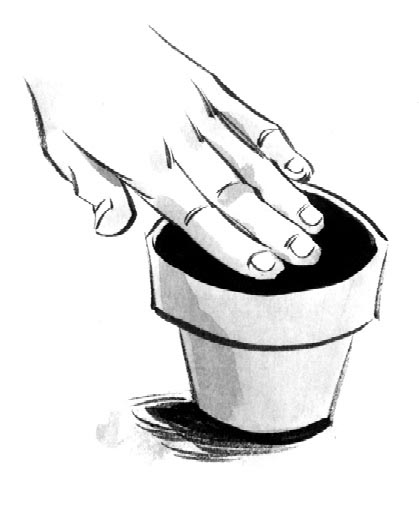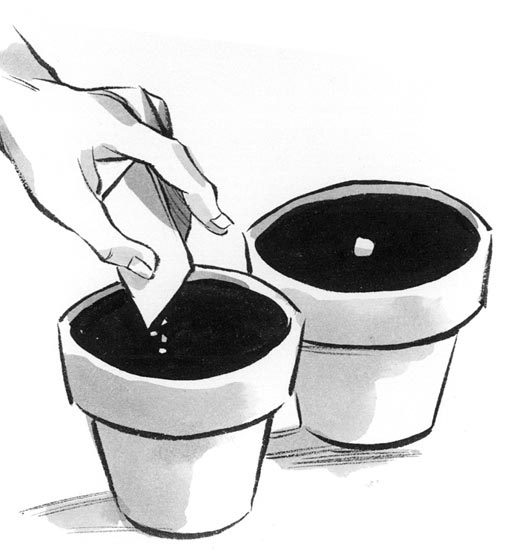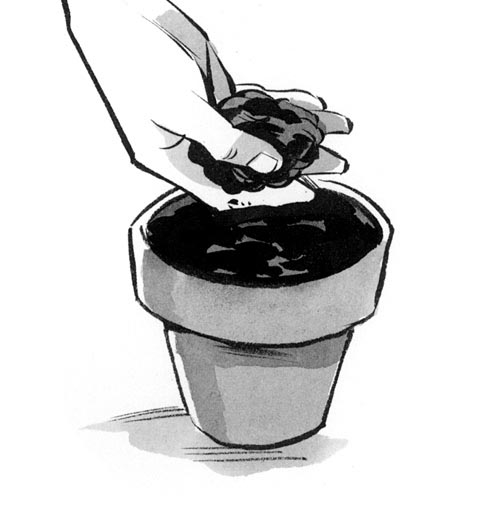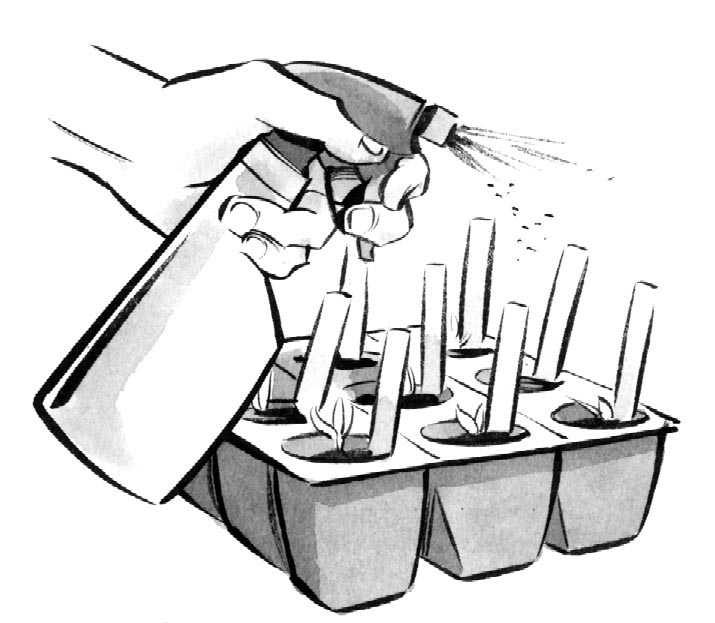Sowing Your Seed
Once you have seeds and necessary equipment in hand, and your calendar says it’s time, the fun begins. Time to start filling pots and sowing seeds! Keep your sowing schedule handy, and make notes as you plant seeds. Records from previous years about what you sowed (and when) are extremely useful for determining the best planting dates and timing for your garden.
Moisten Before You Fill
For best results, moisten the germinating or potting mix before filling pots. Commercial mixes can be very difficult to wet thoroughly, especially in individual pots, and dry pockets in the mix can impair germination. The day before you intend to sow, fill a large bucket with enough mix for the day’s planting. Add plenty of warm water, then stir until all the ingredients are moist. If you can’t premoisten the day before, at least do it a couple of hours before sowing. This allows time for moisture to permeate the entire mix and eliminates dry pockets.
Sowing, Step By Step
After premoistening your germinating mix, read your seed packets to determine whether seeds have any special germination requirements, such as needing light or darkness (see Special-Needs Seeds, page 58). Then use the following steps to sow your seeds:
- 1.Fill each container with premoistened germinating or potting mix. As you fill, tap the container on the work surface to settle it, then gently firm the mix with your fingers. The potting mix should be about ½ inch below the rim of the pot.
- 2.Sprinkle seeds thinly over the surface of the potting mix, or sow 3 or 4 seeds in the center, depending on whether you are planning to transplant later. Use a hand-held seed sower, or place seeds on a small piece of folded paper and tap gently to spread them. Plant large seeds and pelletized seeds individually.
- 3.Use moistened, sifted potting mix to dust over the seeds to a depth just barely equal to thickness of seeds. For very tiny seeds, or seeds that require light for germination, just press seeds onto the surface of the medium.
- 4.Label each container as you go with the name of the plant and the date sown. Set each container in a tray of water, allow the water to soak the soil from below, then move it to another tray and let it drain. Or moisten each container with mist from a spray bottle. Don’t use a watering can or faucet, as even a gentle stream of water can wash seeds away.
- 5.Set containers where the seeds will germinate. Flats don’t need sun until seedlings appear, but it’s often easiest to set them where they will ultimately be growing.
After sowing, keep the germinating mix evenly moist but not wet. Remember that seeds need a balance between water and air. Cover flats with a humidity cover, or cover loosely with clear plastic. Remove the humidity cover as soon as seedlings appear. See From Seeds to Seedlings on page 64 for details on giving germinating seeds and young seedlings what they’ll need to grow.
Easy Vegetables for Starting Indoors
The crops on this list have different schedules, so check seed packets to determine when to sow. All are fairly easy to start from seeds indoors.
- Broccoli
- Brussels sprouts
- Cabbage
- Cauliflower
- Cucumbers
- Leaf lettuce
- Leeks
- Okra
- Onions
- Peppers
- Pumpkins/winter squash
- Swiss chard
- Tomatoes
- Zucchini/summer squash
Gentle Pressure
Seeds need to take up moisture from the seed-starting medium in order to germinate. After sowing, press the medium down gently to provide good seed-to-soil contact. Pressing eliminates air pockets, which can prevent water uptake. Don’t press too hard, though, since seeds also need air, which they get through smaller air pockets in the medium. Gentle pressure ensures that they receive the balance of air and water they require.
Easy Annuals for Starting Indoors
Opinions vary on which annuals are the best choices to grow from seed started indoors. The following are among the easiest.
- Ageratum, floss flower (Ageratum houstonianum) Note: Needs light to germinate; press seed onto the surface of the soil.
- Celosia, cockscomb (Celosia argentea)
- Cleome, spider flower (Cleome hassleriana)
- Coleus (Solenostemon scutellarioides) Note: Needs light to germinate; press seed onto the surface of the soil.
- Cosmos (Cosmos species)
- Impatiens and garden balsam (Impatiens species) Note: Cover seeds very lightly.
- Marigolds (Tagetes species)
- Nicotianas, flowering tobaccos (Nicotiana species) Note: Need light to germinate; press seed onto the surface of the soil.
- Salvias (Salvia species) Note: Need light to germinate; press seed onto the surface of the soil.
- Snapdragons (Antirrhinum majus) Note: Need light to germinate; press seed onto the surface of the soil. Best grown in cool temperatures, 50° to 55°F.
- Statice (Limonium sinuatum)
- Sweet alyssum (Lobularia maritima) Note: Needs light to germinate; press seed onto the surface of the soil.
- Zinnias (Zinnia species) Note: Can be fussy about transplanting; see Pots for Fussy Seedlings on page 42.



